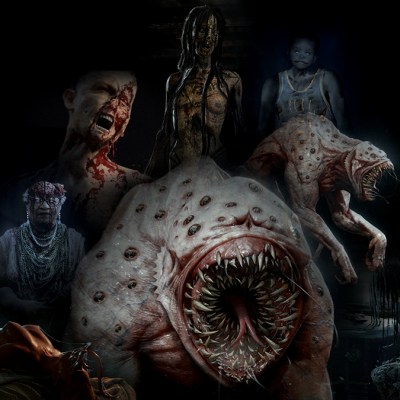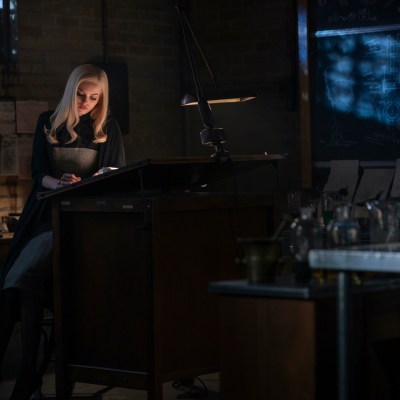Lovecraft Country: Bringing the Shoggoths to Life
VFX supervisor Grant Walker breaks down how Lovecraft Country’s terrifying “guard dogs” were created
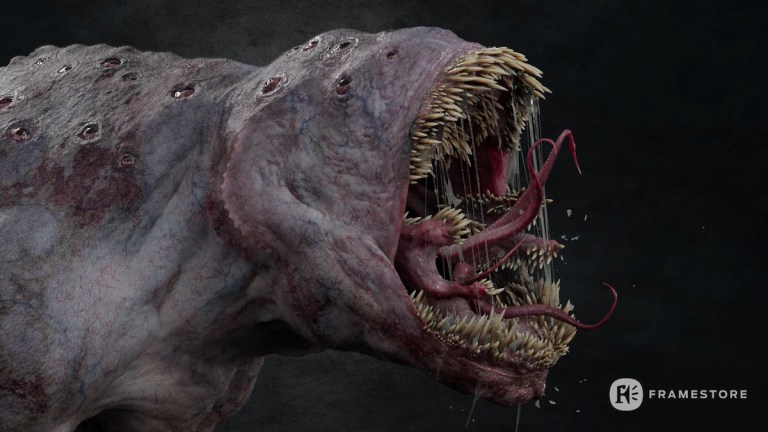
Contains spoilers for episodes 1, 2, 8 and 10 of Lovecraft Country.
Grant Walker is a monster person. “I’m a monster person, indeed.” He confirms. “It’s definitely been there since I can remember.” Raised on a diet of Clive Barker and ‘80s horror, The Lord Of The Rings and painting Warhammer figures, Walker is just fascinated with monsters. So as Framestore’s VFX supervisor on Lovecraft Country, in charge of bringing the shoggoths to life, he’s in his element.
“Misha [Green – creator] briefed us on the character of the shoggoth and it was basically supposed to be the ultimate guard dog. It’s a loyal creature. It’s a guard dog that’s supposed to be terrifying and fierce and powerful. The most important of those, I guess, is terrifying,” Walker explains. “Almost every element about the creature is supposed to be there to terrify you. Its teeth, all the weird eyes it’s got all over its back. It’s got a powerful anatomy. It’s got these little raptor arms for chopping up people and poking them.”
A creature originally described in H.P. Lovecraft’s mythology, Walker says he was still given plenty of leeway to make his shoggoth his own.
“I really wanted to push the teeth. That was the main thing. It was a big, powerful creature that was supposed to be absolutely terrifying, but also slightly otherworldly. It didn’t want to feel like it was just a monster from the zoo. While we base a lot of reference on existing animals like gorillas, big cats, sharks and things like that, it was supposed to have an otherworldly nature about it to give it some sort of eeriness and sit it into the Lovecraft world.”
Shoggoths make appearances in episodes one, two, eight and ten. A surprise ambush occurs in episode one, followed up in episode two when they’re in guard dog mode. Then in episode eight the shoggoth returns for a big gory action scene, while episode ten sees two shoggoths go head to head.
VFX explained
So how do you put a CG shoggoth into a live action scene interacting with actors?
“It is tricky,” explains Walker.
“What we do is we first plan it out with a pre-visualization, a very basic animation where we take a scan from the set so we can build the set in our computers, and we block out the entire sequence with all the actors, with the shoggoth, with all the stuff that’s happening
“That’s to really iron out what we’re going to film, because obviously when we get on set there’s no shoggoth. There’s stunt guys holding puppets but we need to know how fast the shoggoth can run, we need to know what he’s going to do, what he’s going to impact. If he bumps into a car, when do we nudge that car on-set, all those kinds of things.”
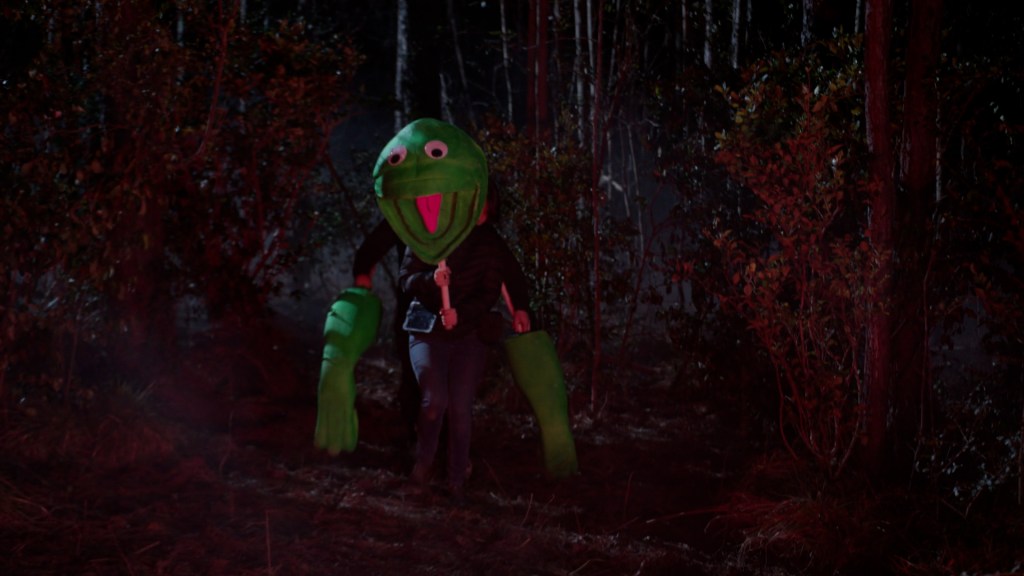
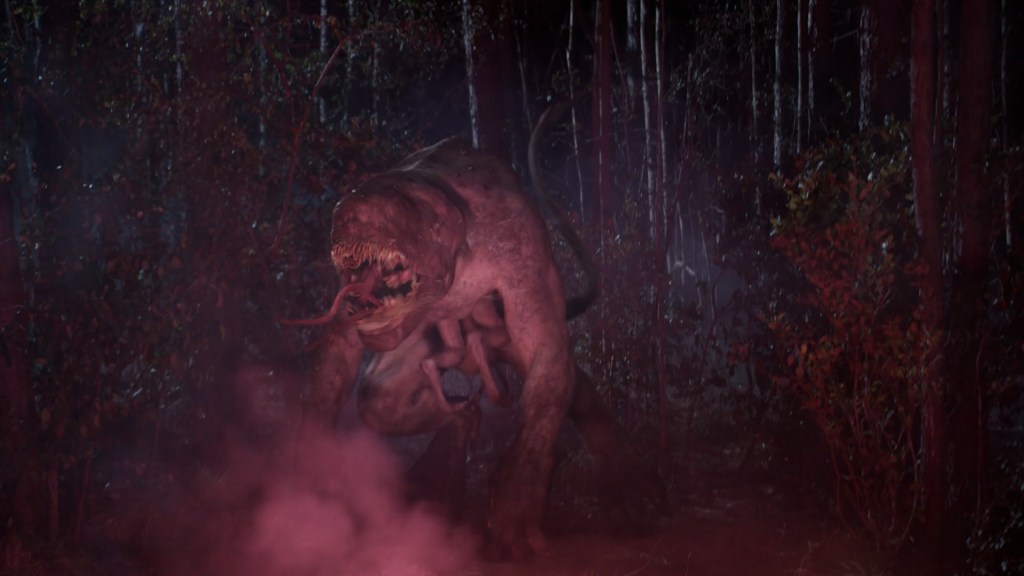
There’s no clear cut rules about what will be done with CGI and what will be practical FX, Walker explains. Instead it’s a case of trial and error and ensuring he always knows what can be achieved in CGI if they don’t get the shot. The scene in episode eight where the rampaging shoggoth tears off Office Lancaster’s (Mac Brandt) arm, for example, originally involved a prosthetic limb, but ultimately CGI worked better.
Molding the Shoggoth
Using the pictures supplied by the art department and with further direction from Misha Green, Walker set about sculpting the shoggoth.
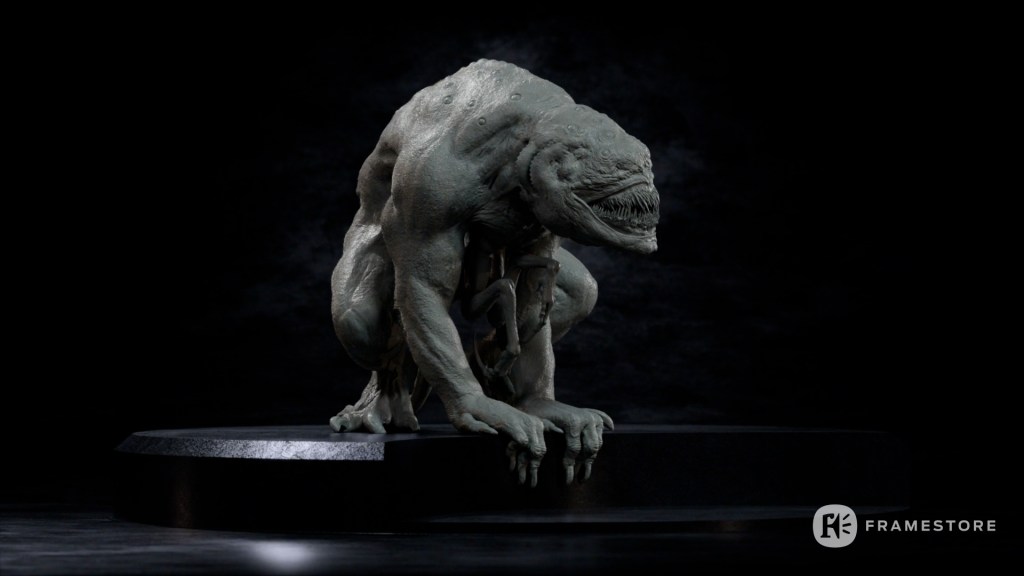
“We basically built a digital sculpture of the shoggoth like you would in clay. Then you build a control rig for animation,” he explains. “On top of that you have to replicate all the anatomy inside [the creature]. We build a muscle system that works with simulation so we can simulate muscles bouncing around, flesh wrinkling and all that kind of stuff in a technical process.”
When he was happy with the musculature, attention turned to attempting to replicate the lighting on set, focusing on the skin of the creature and how it would absorb and reflect light.
“You have to paint all these textures and develop, what we call, shaders that react to light in the way that you would expect certain objects to react to light. You render it using the lights from the set and then at that point you should see your shoggoth sitting pretty much on top of the film plate,” he says. “Then you have a massaging process called compositing where you merge the two seamlessly together.”
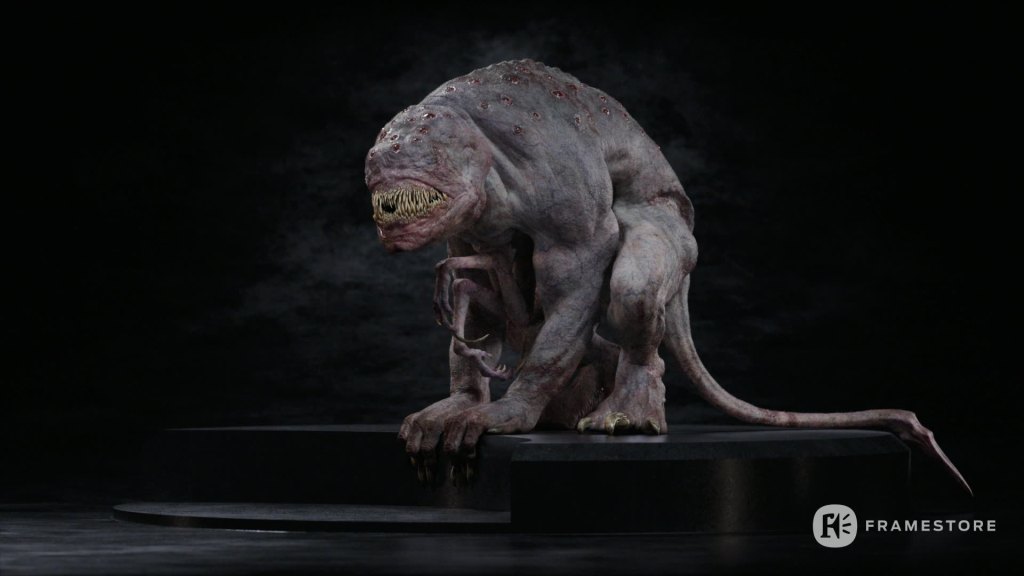
This involves things like adding shadow, painting out bits of blue screen and working with environmental elements like the shoggoth kicking up dust as he runs which could be done via CGI or via a filmed element to really bring it all together.
Guts and gore
Lovecraft Country prides itself on not holding back when it comes to the grue, but this posed more challenges for the team when deciding what should be done in-camera and what would in-computer.
“There’s one significant shot in ep eight where the gore is a big feature that’s in-camera,” says Walker. “There’s this big blood exposure, it covers them. That is the one that I would hate to attempt in visual effects. It’s got too much interaction with the characters. That’s the one significant gore piece that is in-camera. Then there’s the set dressing, which is the blood, guts, arms, prosthetics limbs that are on the floor.”
Blood directly from and around the shoggoth – when it comes from the shoggoth’s gills or when he’s mauling people – was CGI and there were different types of blood they needed to simulate.


“It was surprising how many different types of variation of blood that we needed to do. Blood exploding was one type. Then there’s blood that landed on the ground. From a technical point of view there were probably six, maybe eight, variations of how to produce CGI blood for doing different things. If blood’s seeping into a jumper it’s a textural thing that has to change over time. We also have bits of blood protruding from somewhere and then landing onto something. Then it has to change from one type of data, which is geometry data landing to effect texture. That would turn into another thing. It was quite a complex setup. 90% of it is visual effects blood.”
You can tell monster-man Walker is here for it.
Real life inspirations
Walker got the concept designs from the art department which acted as a blueprint for how the shoggoth would look but Green gave him the greenlight to make tweaks where he saw fit and some of his reference points came from the natural world.
Take the teeth:
“I see all those teeth, but I’m like, ‘Is that the sarlacc pit? Is it just a round thing with loads of teeth in it?’ I want this thing to be able to churn up people’s faces rather than just shaking teeth around. That was one area I was like, ‘Let’s look at teeth that are scary.’
“I saw an angular fish that had these big pointy teeth that jut out at you. Then I looked at a shark’s jaws, because I knew that their teeth operated separately from the main cranium skull. Then we built these mandibles inside the mouth that could act like a food processor for people’s heads.”
Nice.
The shoggoth also has gills at the back of the head which inspired Walker in further grossness.
“When someone said, ‘He’s got gills back there and he eats people’s heads,’ I was like, ‘Oh, sure we can blast the blood out of the back of the head.’ I’m sure I wasn’t the first person to think it…”
Putting the moves on
The next challenge for Walker and his team was how to make the shoggoths convincingly move and for this Walker turned to primates.
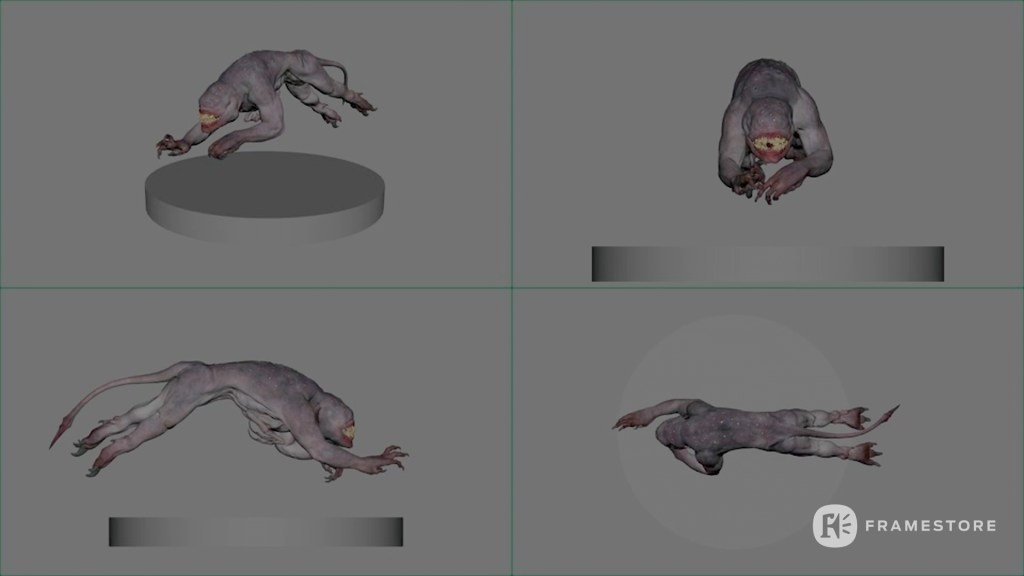
“In terms of also making it move and be powerful, I looked at it and I’m like, ‘All right, it’s muscular, and looks like this it’s running on its knuckles.’ That’s the gorilla,” he says. With the animation supervisor they would look at other references and tweak the anatomy of the shoggoth in reference to the movement, adjusting the length of the arms and the legs and making tweaks until the anatomy matched the motion they wanted.
Eyes in the back of its head
From the original Cthuhlu mythos the shoggoth was covered in eyes but Walker wanted to adjust exactly where they were situated.
“We put their eyes on the head and the back. We removed them a bit from the shoulder. They felt a bit strange on the shoulder. We were thinking that maybe its brain is in its head. You can imagine that the spinal column might have some sort of optical nerve that might tie it all together. But to be on limbs as well pushed too far. I did feel I’d like to try to keep it around the spinal column at least,” he explains.
“In terms of how that affected the animation and the character was quite interesting because the idea is this creature can see in pretty much any direction. Most creatures hear or see something and they turn their head to look at it. Well, this doesn’t need to. How do you make the creature look at something without needing to turn its head? There was a bit of a trade off there. We did ultimately use the head and little looks, but there are some shots where it’s mainly in the eyes.”
Big mouth strikes again
With the eyes scattered around the shoggoth’s head and neck and the pupils not easily identifiable – they are either have slight cataracts or they’re almost entirely black – much of the shoggoth’s facial focus is on the mouth. As well as the teeth, the shoggoth’s tentacled tongue became an important aspect of the design.
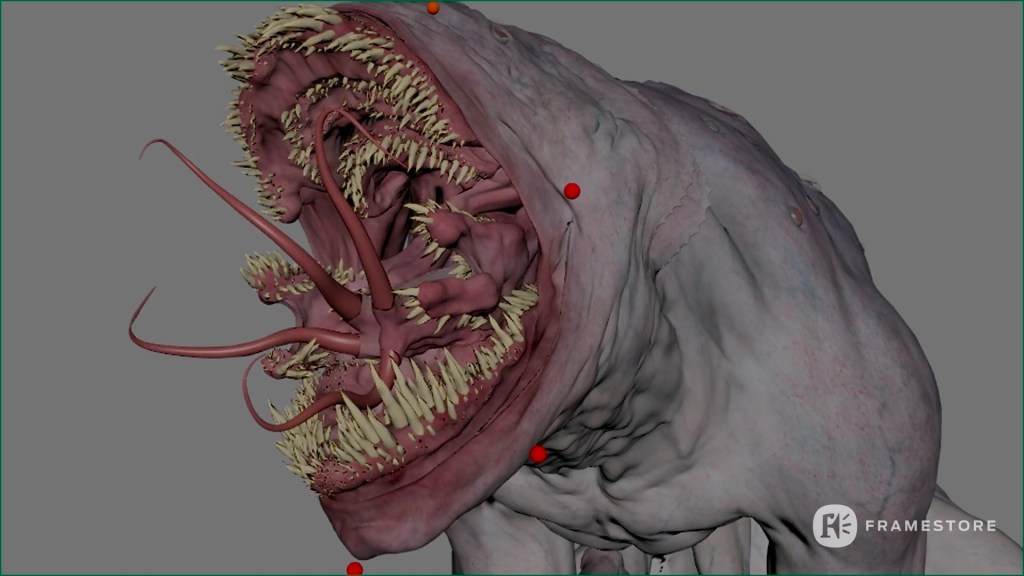
“When you’ve got a mouth as big as this, you have to spend a lot of time controlling it. This one was a pretty big feature. We spent a lot of time working on where the lips should start and finish. I did do a version where the lips were closed over the teeth, which kind of looked a bit like a weird Kermit the Frog and became immediately less terrifying,” deadpans Walker.
The tongue was another big focus.
“There were a couple of concepts from our art department where they had a single tongue, double tongue, and a four tongue kind of thing but the ends of it were quite short,” Walker explains. He had his heart set on something bigger, a longer, twistier tongue that could feel like a weapon, with barbs down the side he says were inspired by the barbs on a cat’s tongue.
The shoggoth is a scary beast. There is also something grotesquely phallic about it.
“It’s weird you say that because I’ve done a number of creatures and it’s often a comment about creatures that I make. It must be something subconscious that creeps into these creatures. I don’t know what it means. I’m not going to analyze it too much. But yeah, I have no good explanation for that,” says Walker. We’re not going to push.
Under the skin
The skin of the shoggoth was another element that took work. Walker says the plan was always to make the skin slightly translucent which meant building the skeleton, muscles and vein system beneath the skin so that you can see into it a bit if you shine a torch at it.
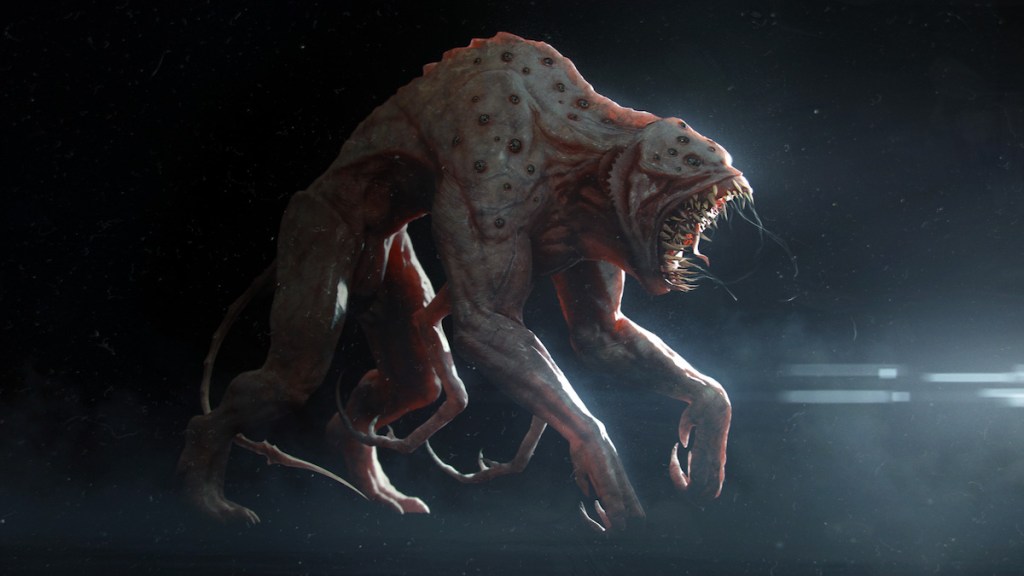
“There’s some kind of red gnarly stuff all over his skin as well,” says Walker. “They’re supposed to be creatures that haven’t seen the sun or don’t like light. So the skin was always supposed to be a bit sickly. That scarring, also was an artistic way of creating variations. There’s a few of these, what we call white shoggoths, in the episode so we needed to have a few variations.”
The money shots
Walker says episode eight was the biggest challenge, in particular the sequence where the shoggoth goes on the rampage and bites Lancaster’s arm off.
“When a monster is interacting closely with a human being, you need to make sure it’s either moving that person or it’s physically affecting that actor, but also that it’s casting shadows correctly,” says Walker. Sequences like this are where the pre-vis comes into its own, he explains, “you’re filming all this action going on and there’s one significant thing missing, which is the shoggoth.”
Walker says they’d been working on this sequence for around five months, and that’s not including the pre-vis which they completed over a year ago.
The shoggoths get a final hoorah in episode ten, in several sequences where you see it close up, not on the rampage “It’s more chill, it’s in bodyguard mode, it’s just following around and you get to see it in a bit more detail in certain shots,” says Walker, while there’s another scene where two shoggoths have a scrap (“he’s going to bob, with his little paws and he’s going to wait up and he’s going to throw a right hook…” boxer Walker describes acting it out for the animator).
Walker says the show’s been a joy to work on, and he’s even enjoyed watching it back, though he doesn’t always like to look at his own work – surely an indication of the quality of his creation. The show has been a success and while there is by no means any guarantee any sort of second season will materialise, if it does, we’d fully expect to see more of Walker’s supernatural guard dogs – for the merchandising opportunities if nothing else. Because after all, who wouldn’t want a shoggoth of their very own?
Lovecraft Country is available to watch on-demand on Sky Atlantic and NOW TV.

